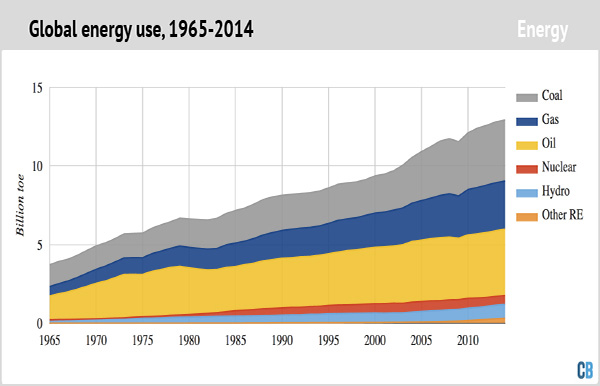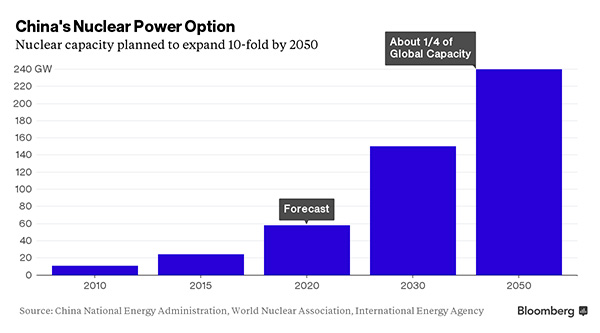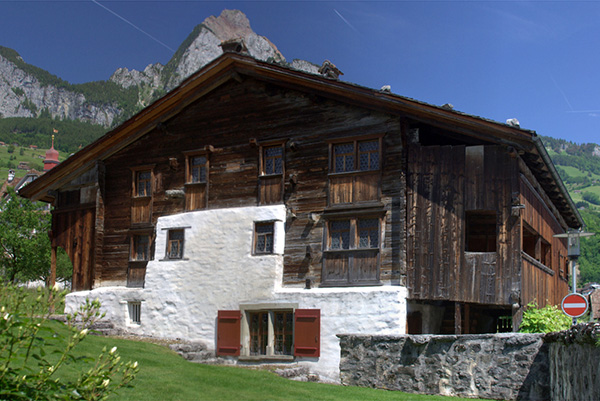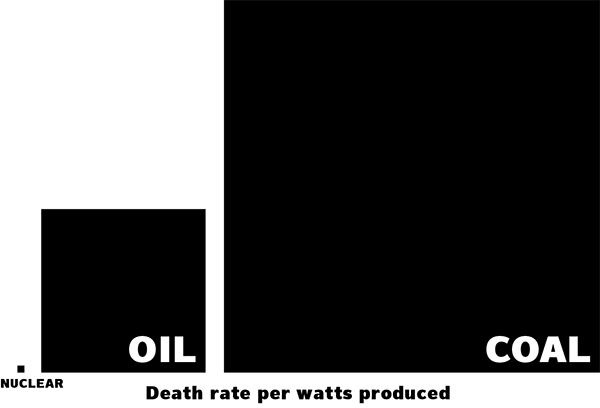Post-Paris apocalypse ou la climate quantitative easing

Spot the Renewable Energy: For renewables to replace the 11 billion tonnes oil equivalent of fossil fuels used annually in anything like the Paris target of 35 years, from the skinny brown slither that represents biomass, solar, wind and geothermal here, is an outright impossibility, yet renewable power ideologues adhere to their anti-nuclear power dogma ahead of averting runaway global warming. Fortunately China, whilst making a fortune from the filthy photovoltaic panel manufacturing process—and an even more disgusting one for electronics generally—to feed the West’s fetish for these products, is building nuclear power stations at a rate unseen since France significantly decarbonised its electricity generation, following the first oil shock. chart Carbon Brief
Post Paris, the obligatory image accompanying stories heralding the historic 195-country agreement is of banks of photovoltaic panels.
If that does prove to be the immediate future, along with massive wind farms and millions of electric cars, global warming will go largely unchecked. But rather than tediously enumerate why solar and wind will not safeguard a survivable climate, it is probably more productive to first state what some of the essentials a suite of effective responses might include.
The absolute prerequisite is for the response to be radical. With the North Pole on Wednesday a whopping 28° warmer than normal for the time of year—a rude reminder that the Arctic is the fastest-warming region on Earth—the spectre is again raised of a potentially catastrophic release of methane from undersea clathrates and from decaying permafrost. Whether this release of methane, which has an initial 100-times-more-powerful global warming effect than carbon dioxide, proves to be as dramatic as many scientists fear, or not, there should be little doubt about the need for climate action to be radical and urgent, if indeed it is not already too late.
The suite can be divided into two halves: That of which much less is required, and that of which vastly more is required. Beginning with the latter, vastly more wood must be grown and vastly more wood grown must be locked up in long-lasting applications. Vastly more energy must be conserved, but also vastly more ultra-low-carbon energy must also be produced, in order to efficiently build and power replacements for the existing high-carbon infrastructure, which otherwise will guarantee ongoing ruinous levels of greenhouse gas emissions. Simultaneously, a radical reduction is needed in birth rates, in travel—from commuting by car to air travel, and everything in between—in shipping, in the use of concrete and steel, and in consumerism generally.

China Doing the Heavy Low-Carbon Lifting: While the West sits on its nuclear-phobic hands, China is rapidly accelerating its ultra-low-carbon power generation with a US$1 trillion programme. Given that the West has largely abdicated its manufacturing role to Asia, civilisation will owe its survival to those countries, which include India, that are realistic about the limited contribution that non-nuclear renewables can make in supplanting fossil fuels. chart Bloomberg Business

More Ancient than Switzerland: The timber in this house in Schwyz has kept its carbon sequestered for 728 years after the trees involved were felled, and timber from a 33-year-older house disassembled nearby is in storage. Whereas the Swiss use a similar percentage of hydro power to New Zealanders, 56.4% and 55% respectively, because they use 37.9% nuclear, Switzerland’s electricity is 96.5% carbon free. image Vance Family
Currently, New Zealand’s reputation for putting skin in the climate action game all rests on its considerable work towards reducing pastoral greenhouse gas emissions. While it is sound to take a strictly disciplined, strategic approach, this urgently needs to be expanded to embrace forestry, where Aotearoa was once a world leader. Twenty-five-year-rotation radiata pine, conceptually, provides the fastest route by which Aotearoa can draw down and sequester meaningful amounts of carbon dioxide. Actively growing forests draw down carbon dioxide whereas those that have matured merely store it. The prerequisite, if that carbon is to remain sequestered, is for as much of the wood harvested as possible to be put to long-lasting uses, while the land produces a subsequent, actively growing forest crop.
The prime candidate for long-lasting wood-based infrastructure is, of course, buildings. But not the sort that the New Zealand building industry has simultaneously blighted its reputation and that of radiata pine with: leaky homes. To guarantee the carbon is locked up indefinitely, the wood needs to be used in the precise manufacture of high-quality modular buildings engineered to last centuries. The modular aspect is critical in order that all the processes are carried out under optimal conditions—a far cry from waterlogged framing semi-sealed onsite beneath problematic monolithic claddings. Rather than continue to export radiata pine logs, Aotearoa should be sending shiploads of high-cube-container-dimensioned building modules worldwide, but particularly to those countries with significant populations living close to sea level, thus ensuring new buildings are not stranded but can be progressively relocated inland as part of a strategy of a humanely managed retreat.
Manufactured modular construction is also the only route out of New Zealand’s housing crisis, on two counts. Current construction practices are overly slow, inefficient and expensive, with the only real winner being the banking sector. But these labour and material-intensive building methods also result in housing stock of low durability—infamously so in the case of leaky homes—and inflexibility, resulting in a service life measured in decades rather than centuries. Modularity should sharply diminish the need to demolish buildings no longer fit for purpose—the more common reason for buildings to be replaced, as opposed to deterioration of the structure.

Modular and Spacious: Dwellings based on high-cube shipping-container-sized modules can be as compact or spacious as required. This detached art studio was constructed from two actual high-cube shipping containers. Not only are housing shortages critical now, global population is forecast to reach between 9.5 and 13.3 billion people and growing by 2100—the higher number would almost double today’s population. And given that steel and cement production accounts for about 12% of anthropogenic greenhouse gas emissions, wood must replace cement and steel wherever possible in the buildings manufactured for all those extra people. image Maziar Behrooz Architecture

Fearfully Hard to Explain: When historians of the future attempt to explain why Western civilisation was allowed to fail, or risk doing so, the particularly challenge will be to account for the irrational fear, at the time, of what might happen if nuclear power—the only technology that had proved capable of large-scale energy decarbonisation up to that point—was used to rapidly decarbonise energy, when the deaths from nuclear power generation were running at 0.04 per terawatt hours as compared to 0.44 terawatt hours for all solar. chart concept Seth Godin
Radiata pine, it should go without saying, shouldn’t be the only species deployed, particularly given the historic, lamentable lack of planted indigenous forest in Aotearoa. But because the carbon drawdown performance of indigenous is significantly lower, a stringently strategic approach to land-use change is called for, where these slower growing but higher value species can provide additional important services, such as biodiversity, and riparian protection, particularly when matched to continuous-canopy timber extraction, rather than clear felling. In an ideal world, land use management would maximise the wild areas preserved or restored, free of any form of extraction. However, having squandered 28 years and counting without decisive climate action, land use must now be rigorously prioritised to meet the triple needs of mitigation, adaptation and food production—the latter, until such time a breeding moratorium can kick in. While this inevitably means that the fastest-growing, supply-chain-established species, radiata pine, needs to continue to make up the majority of new plantings, the imperative to establish as many trees as possible provides an unprecedented opportunity to establish indigenous forests on the scale of the heroic exotic plantings of the 1920s and 1930s.
Returning to so-called renewables. Lest the impression was given at the beginning of this piece that there is no place for photovoltaic and wind in a rapid response to global warming, there certainly is, but only where used strategically. The issue is surprisingly complex, but the fact that so many environmentalists previously opposed to nuclear power now warn that to rely only on photovoltaic and wind would constitute an unacceptably high-risk gamble, should encourage reasonable people to rigorously re-examine the basis for any anti-nuclear-power beliefs they may hold. Potentially, the electricity sector is the easiest to decarbonise but, at about 20% of all energy delivered, to have any chance of decarbonising the other 80%, everything that can be electrified must be, from buses to entire ports, not to mention the domestic electrification the West has enjoyed for a century that is still denied 1.3 billion people and growing. Time and money are the two commodities that cannot, in conscience, now be squandered. Yet a 2013 study found that the cost of abating one tonne of carbon dioxide emissions in Germany was €44 with wind power, but €537 with photovoltaic. It would be perverse in the extreme to prolong fossil fuel use and energy poverty in the knowledge that air pollution is killing seven million every year, and reject nuclear, which has killed fewer than that in total, in the 73 years since the Manhattan Project—including Hiroshima and Nagasaki, weapons testing, and Chernobyl. Meanwhile, radiation from Fukushima has killed no one, nor is likely to, at least at any level that can be detected.
Paris predictably failed to discuss, much less agree upon addressing, global warming’s parent problem—population growth. While it will doubtless be argued that no agreement would ever have been reached if the axiomatic need to reverse population growth had been a component of the talks, it is increasingly doubtful that dodging this cardinal emissions-multiplier constitutes a viable strategy.
Just as Paris is all piss and wind, in the absence of rapid and radical climate action by the signatory states, countries that do no more than implement an emissions trading scheme, or even a carbon tax, will fail to reduce fossil fuel use fast enough to be doing little more than going through the motions. What has proved to work, and on a global scale during the World wars, was pioneered by the French to prevent their republic being reclaimed by monarchists—mobilisation. Nor is financing that mobilisation economically challenging, as climate quantitative easing advocates pointed out in Paris:
We [printed] the money to save the banks, we now need to do the same to save the planet.
Post-Paris, a rapid and radical quantitative-easing-financed mobilisation is infinitely preferable to inaction, and rapid and radical changes to the global climate.
